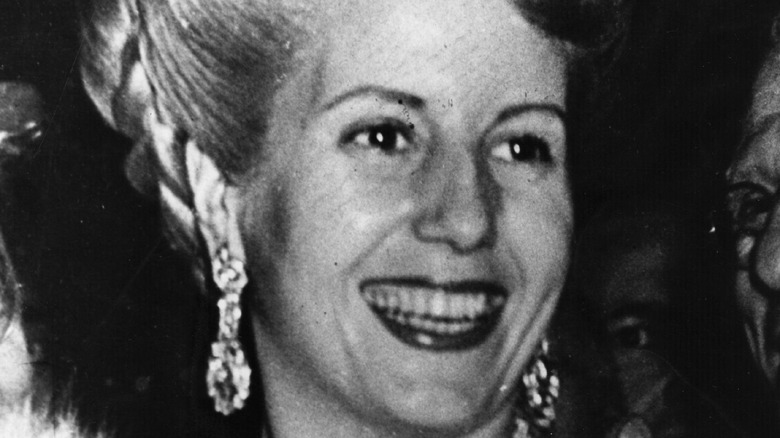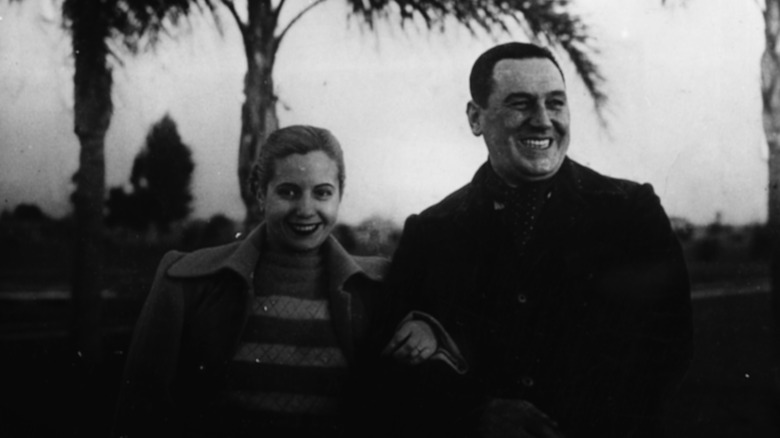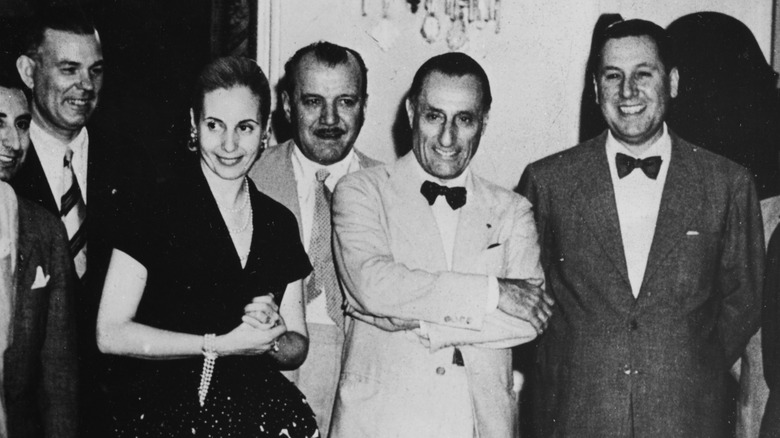The Tragic Truth About Eva Peron's Lobotomy
Eva Peron was Argentina's first lady from 1946 until her death in 1952. She was born Maria Eva Duarte in 1919 and had humble beginnings. As a young girl, Eva showed interest in acting and often held performances for her family together with her sister. At 15 years old, as reported by Biography, Evita moved to Buenos Aires and began her acting career. She primarily worked in theater productions before landing her first movie role in 1937. In addition, she also appeared in radio programs and eventually established her own business producing radio shows.
In 1943, Eva met politician Juan Domingo Peron. They married two years later, and Eva had an active role during her husband's campaign for the presidency, which he won in 1946. As a first lady, Eva became a champion for the working class, women, and the poor citizens of Argentina (via Amy's Smart Girls). Sadly, Eva passed away from cancer in 1952 at the young age of 33.
Eva Peron's cancer diagnosis was kept from her
Eva Peron started having health problems when she was 30 years old. According to The New York Times, the first lady of Argentina fainted during a public appearance and had to undergo an appendectomy. After the surgery, however, Peron experienced other health issues. She became weak and was said to be anemic, and furthermore, she suffered from vaginal bleeding. She was then diagnosed with cervical cancer, but the information was kept from her and the public.
As reported by Medical Bag, Eva underwent a hysterectomy in 1951, but unbeknownst to her, her husband had a Manhattan cancer surgeon, Dr. George T. Pack, perform a procedure. Dr. Pack was able to remove the cancer but discovered that it had already metastasized to her abdominal area. Eva had two surgeries, which she thought were performed to cure her bleeding. Many believe that Juan kept Eva's diagnosis a secret, as his wife had a big role in his presidential campaign for the 1952 elections, and the information about his wife's failing health might influence their votes. Eva again experienced abdominal pains in February 1952, and it was discovered that her cancer had returned and was spreading rapidly.
She underwent a lobotomy
In the 1950s, lobotomies were performed on patients with varying health conditions. The procedure involved damaging or severing nerves in the frontal lobe in order to alter the patient's behavior. As noted by Live Science, lobotomies were typically performed in patients diagnosed with mental illnesses, such as bipolar disorder, depression, or schizophrenia. However, it was also done to patients who had cancer and experienced pain. Lobotomies were first performed in the 1880s, and the procedure — although having mixed results — quickly gained popularity. By the early 1950s, more than 50,000 lobotomies have been done in the U.S. alone.
In 2005, neurosurgeon George Udvarhelyi claimed that he was one of the doctors who helped in the treatment of Eva Peron, and he revealed that the former first lady underwent a lobotomy, according to The New York Times. Dr. Udvarhelyi's assertion was contested by some, but it couldn't be confirmed, as Eva's medical condition was kept private, and her cervical cancer diagnosis was only revealed after her death. In fact, Eva herself died not knowing that she had cancer.
The evidence of Eva Peron's lobotomy
In 2011, Dr. Daniel Nijensohn and his team of researchers uncovered pieces of evidence confirming Dr. George Udvarhelyi's claim that Eva Peron had a lobotomy shortly before her death. X-ray scans of Peron's skull showed drill holes that were consistent with a lobotomy, as reported by BBC. Furthermore, Dr. Nijensohn contracted other medical professionals who worked on Eva, and they confirmed that the procedure was done in secret without the first lady's consent. The lobotomy was reportedly done by a neurosurgeon named James Poppen, who died in 1978.
As noted by Dr. Nijensohn, the lobotomy was most likely Juan Peron's last resort to ease the pain his wife endured from cancer. Reports also said that Eva's behavior changed drastically near the time of her death, and she was belligerent. One of Dr. Poppen's nurses, Manena Riquelme, said that the procedure was done in the palace where a makeshift operating room was set up, and there was an armed guard stationed nearby to ensure the procedure would be kept secret.
Eva Peron's death
After Eva Peron's lobotomy, she reportedly appeared calmer but her physical health suffered. As noted by a BBC report, she stopped eating and weighed only 82 pounds during her last public appearance, which was at Juan Peron's second presidential inauguration held on June 4, 1952. She was allegedly so weak during the event that she had to be supported by plaster wire on her limbs to help her stand properly. She died less than two months later on July 26, 1952.
Her death was announced on the radio, and millions of Argentinians mourned the loss. Her body was put on display in Buenos Aries in order for the public to pay their final respects. As reported by Time in 1952, approximately 700,000 people attended and waited for several hours in line just to get a glimpse of the first lady. There were incidents of trampling and thousands of people were treated for injuries. In addition, there were also tributes throughout different locations in Argentina.
The end of lobotomy
Based on his research, Dr. Daniel Nijensohn surmises that Eva Peron had the lobotomy sometime in May or June 1952, which meant that she already had the procedure done before her husband's second inauguration. However, what he couldn't answer is whether the procedure worked. Some believe that it may have controlled Eva's behavior but hastened her death (per BBC). Another lingering question is what Juan Peron's motives were when he had his wife lobotomized.
By the 1950s, many started investigating the side effects and dangers associated with lobotomies, and with the risks made publicly known, the procedure became less popular. In addition, drugs for mental illnesses became widely available, which made it easier for patients to alleviate symptoms without having to undergo a lobotomy, according to Psych Central. Soon after, many countries illegalized lobotomies. In the United States, the procedure is almost never done today but is still legal. Neurosurgeons now resort to what is known as a cingulotomy, wherein brain tissues are deactivated to treat chronic pain and other illnesses, such as obsessive-compulsive disorder, but it is only typically done as a last resort. With the advancement in technology, the procedure has few side effects and is non-invasive.





